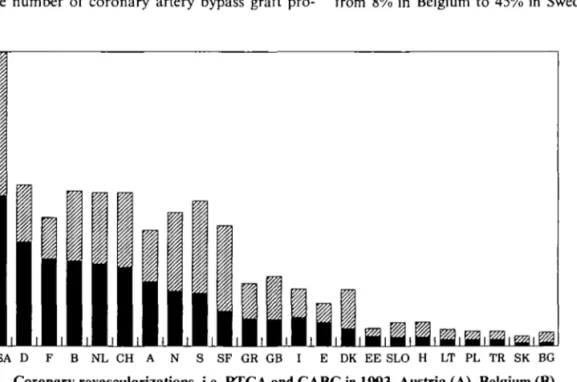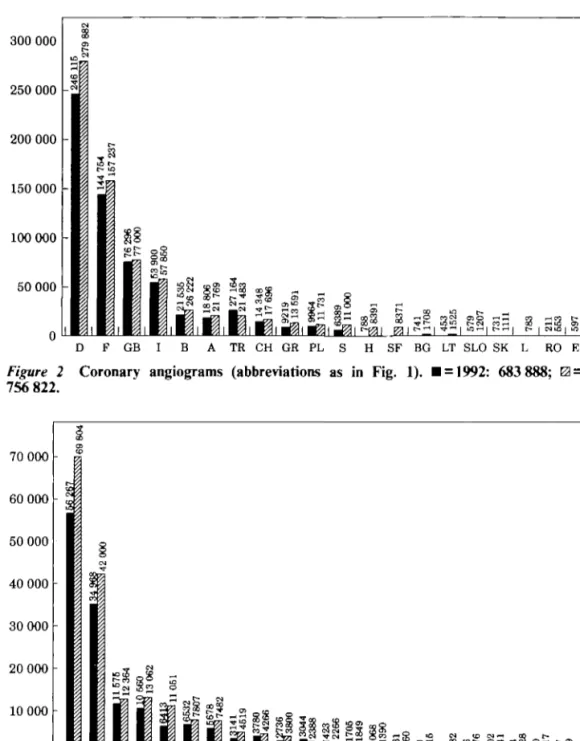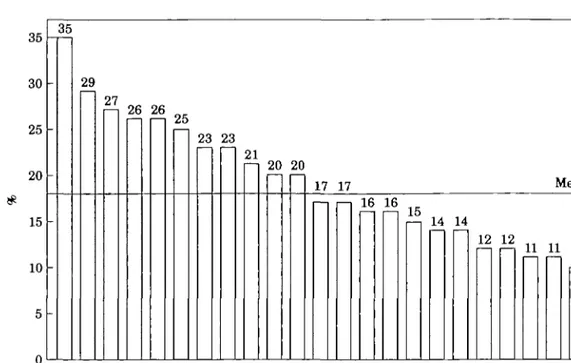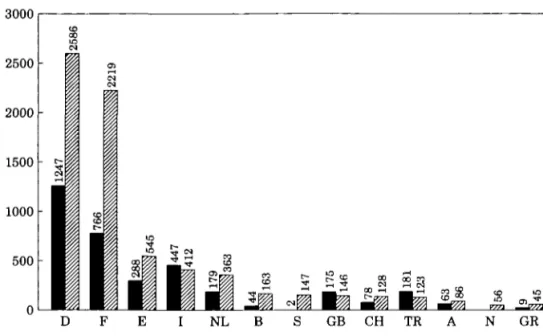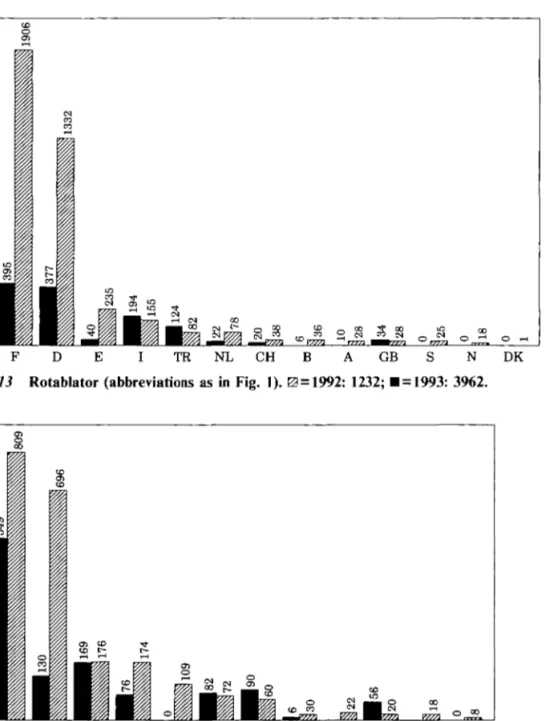Working Group Report
Interventional Cardiology in Europe 1993
B. J. Meyer, B. Meier, T. Bonzel, J. Fabian, G. Heyndrickx, M.-C. Morice,
V. Miihlberger, F. Piscione, M. Rothman, W. Wijns, and M. van den Brand, for the
working group on Coronary Circulation of the European Society of Cardiology
An annual survey on cardiac interventions in Europe isperformed by the working group on Coronary Circulation of the European Society of Cardiology with the help of the national societies of cardiology. A questionnaire about cardiac interventions in 1993 was mailed to a representative of the national societies of 35 members of the European Society of Cardiology. The data collection of coronary interventions was delayed by slow backreporting and from 10 of the 35 national members data were missing or grossly incomplete. They were excluded from the analysis. Coronary anglography A total of 756 822 coronary angiograms were reported resulting in an incidence of 1146 ±1024 per 106 inhabitants, ranging from 24 (Romania) to 3499 (Germany). This represents an increase of 12% compared to 1992. Germany (279 882 cases), France (157 237), the United Kingdom (77 000), Italy (44 934) and Spain (37 591) registered 79% of all the coronary angiograms performed.
Percutaneous transluminal coronary angioplasty A
total of 183 728 percutaneous transluminal coronary angioplasty cases were reported in 1993, 24% more than in 1992. On average, they accounted for 18 ± 7 % (range 8 (Romania) to 35% (Sweden)) of the coronary angiograms. Most of these percutaneous transluminal coronary angio-plasties (82%) were confined to a single vessel. In 13% only, percutaneous transluminal coronary angioplasty took place immediately after the diagnostic study. Adjusted per capita, Germany ranks first with 873 percutaneous transluminal coronary angioplasties per 106 inhabitants, followed by France (737), Holland (725), Belgium (713), and Switzerland (665). The European mean of percutaneous transluminal coronary angioplasties per 106 inhabitants was 270 ± 279, representing an increase of 14% compared with 1992. A major in-hospital complication was reported in
3-8% of the patients undergoing percutaneous trans-luminal coronary angioplasty: 0-6% hospital deaths, 1-5% emergency coronary artery bypass graftings, and 1-7% myocardial infarctions.
New devices In 1993 stents were implanted in 6444 patients (3-5% of all percutaneous transluminal coronary angioplasty patients), equally distributed between bail-out situations (53%) and elective procedures. The 14 stent implanting countries showed a mean increase in the incidence of coronary stenting of 53% compared with 1992. Other interventional devices were applied in 7045 cases, i.e. 3-8% of all percutaneous transluminal coronary angioplasty cases. Coronary ultrasound (2194 cases) and coronary angioscopy (380 cases) were performed infrequently. Non-coronary Interventions Valvuloplasties were the most frequently performed non-coronary interventions. Six European countries performed more than 300 plasties each in 1993. Most of them were mitral valvulo-plasties in southern countries.
Conclusions Although partial backreporting might bias conclusions, several findings of this survey are noteworthy for the participating countries: The number of percu-taneous transluminal coronary angioplasties is universally increasing. There is an extremely wide range of coronary angiography and percutaneous transluminal coronary angioplasties performed per population. The most common additional procedure is a stent implantation while other new devices are only rarely applied. Mitral valvuloplasty is the most frequently performed non-coronary intervention. (Eur Heart J 1996; 17: 1318-1328)
Key Words: Coronary angiograms, PTCAs, stents in Europe 1993.
Revision submitted 26 January 1996, and accepted 26 January 1996.
Correspondence: Bernhard Meier, MD, Professor and Head of Cardiology, University Hospital, 3010 Bern, Switzerland.
Introduction
Coronary artery disease is a major cause of morbidity and mortality in Europe. Since the introduction of coronary bypass surgery in 1969(1'21 and percutaneous transluminal coronary angioplasty (PTCA) in 1977[3) ever increasing numbers of patients have been treated for symptomatic coronary artery disease with these revascularization modalities. Cardiac surgery and inter-ventional cardiology techniques are mostly complemen-tary in modern therapy of coronary, valvular and congenital heart disease and have gained wide accept-ance by physicians and patients. However, the utiliza-tion of these procedures varies widely between European countries in terms of absolute and relative numbers of revascularization procedures. Each technique needs con-tinuous evaluation in respect of immediate and long-term results including side effects, morbidity, and mortality. In addition, it is necessary to analyse whether the differences in coronary artery bypass grafting, per-cutaneous transluminal coronary angioplasty, and other interventional techniques among European countries are caused by differences in perception of the medical need for revascularization procedures, different socio-medical-economic situations, and differences in cardio-vascular morbidity. This information would form the basis of determining the desired national and European level of facilities for revascularization procedures, establish guidelines for their indications, and introduce quality control measures.
Following a survey focussing on the economic aspect14', the working group on Coronary Circulation published its first report of European data on cardiac interventions performed in 1992[5). Other surveys have evaluated the number of coronary artery bypass grafts, coronary angiograms, and percutaneous transluminal coronary angioplasties of individual countries16"91 and in Europe1'01, reflecting the need for annual reporting on coronary interventions. This second survey was conducted by the study group on Clinical Issues of the working group on Coronary Circulation and was intended to collect data on coronary interventions per-formed in 1993 from all countries belonging to the European Society of Cardiology.
The principle aim of this survey was to evaluate the 1993 incidence of various coronary interventions adjusted per population of the particular country and to analyse and compare the data of all participating European countries with the data of 1992. The major complications were also registered for a first attempt at quality control.
Methods
In March 1994 a detailed questionnaire was sent to the presidents or designated delegates of the national cardiac societies belonging to the European Society of Cardiology. As for the previous survey, they were asked to send a copy of the questionnaire to all the centres
performing coronary angiograms and coronary inter-ventions in their country, to collect all the data from these centres, to pool their numbers, and to return a summary of the national data. Attached to the questionnaire were instructions and examples on how the questionnaire should be completed.
The following definitions were used:
Coronary angiogram: Diagnostic catheterization with coronary angiography, irrespective of whether per-formed in conjunction with other diagnostic studies or PTCA.
PTCA: Coronary angioplasty procedure (case), irrespec-tive of instrument used, the number of lesions or vessels dilated, whether a diagnostic study was carried out during the same session or whether the patient had an additional procedure during the same year.
PTCA during diagnostic study. PTCA procedure performed in a single session immediately following a diagnostic study producing the indication for PTCA. Myocardial infarction: According to the most sensitive screening procedure used locally.
Single vessel PTCA: PTCA of one or more lesions in one vessel.
Multivessel PTCA: PTCA of more than one vessel in a single session.
PTCA for acute infarction: PTCA during ongoing infarction with or without fibrinolysis (direct PTCA).
The initial deadline for backreporting was July 1994. In cases of missing or incomplete data, the national centres were repeatedly reminded at increas-ingly shorter intervals. In July 1995 the registry was closed.
Results
The questionnaire included more than 40 questions. The high number of questions may explain why backreport-ing was takbackreport-ing more than one year in some countries. Of the 35 countries, 10 had to be excluded from the analysis because of missing or grossly incomplete data. These were Algeria, Cyprus, the Czech Republic, Egypt, Iceland, Ireland, Morocco, Portugal, Russia, and Tunisia. The data of the 25 remaining nations with a total population of 525 millions are described. They comprise all those with high interventional activity. The completed registry was returned to the country representatives for correction before final compilation. For comparison, some of the 1992 data'51 are recalled.
General results
A total of 683 888 coronary angiograms and 147 729 PTCAs had been reported for 1992. The figures for 1993 were 756 822 angiograms and 183 728 PTCAs, repre-senting increases of 11% and 24%, respectively. The vast majority of PTCAs were carried out electively (87%) and were confined to a single vessel (82%). PTCA for acute infarction was attempted in 2606 cases. Major
Table 1 Major complications
In-hospital death Need for urgent CABG Myocardial infarction of PTC A 1992 0-5% 1 3% 1-5% 1993 0-6% 1 5% 1-7% CABG = coronary artery bypass grafting
complications were reported with a comparable inci-dence in 1992 and 1993 (Table 1). The overall use of new devices including stents, other new therapeutic devices such as directional atherectomy, rotablator, laser, and transluminal extraction catheter as well as new diagnos-tic devices such as coronary ultrasound and coronary angioscopy was 5-7% and 8-7% of all PTCAs in 1992 and 1993, respectively. Of the new therapeutic devices used in 1993, stents accounted for 3-5% of PTCAs (1992: 2-2%), rotablators for 2 1 % (1992: 1%), and directional atherectomy for 1-3% (1992: 08%). The use of lasers and the transluminal extraction catheter decreased.
Data analysed per nation
Figure 1 shows the European revascularization proce-dures reported in 1993. The rates of PTC A in Europe varied from 3 to 873 per 106, and for CABCr1'01 from 2 to 776 per 106. The relative contribution of each revascularization modality varies widely between countries. Northern countries favour the use of bypass surgery, while western countries use more angioplasty. Since the number of coronary artery bypass graft
pro-cedures were collected by the referring cardiologists, backreporting in some countries was insufficient. Miss-ing data were therefore filled in from the data of Unger110'. For reference, estimated numbers for the United States are shown in the first column. In all European countries the number or revascularization procedures is considerably lower than in the United States, where probably more than 2500 procedures per 106 inhabitants were performed in 1993.
The total number of coronary angiograms and PTCAs in 1992 and 1993 are shown in Figures 2 and 3. The four countries Germany, France, Great Britain, and Italy performed 76% of all coronary angiograms and 75% of all PTCAs. The highest incidence of coronary angiograms per population was reported from Germany followed by France and Austria (Fig. 4). The European mean was 1146 ±1024 coronary angiograms per 106 inhabitants, which represents an increase of 12% compared to 1992. Germany also reported the highest rate of PTCA per population followed by the Netherlands, France, Belgium, Switzerland, and Austria (Fig. 5). The European mean of PTCAs per 106 inhabitants was 270 ± 279, repre-senting an increase of 14% compared to 1992. The ratio of PTCAs per coronary angiograms in 1993 was highest in Sweden (35%) and Belgium (29%) and low-est in Hungary (8%) (Fig. 6) while the European mean with 19 ± 7 % was unchanged compared with 1992. A comparison of the countries in western and eastern Europe shows a markedly lower number of coronary angiograms and PTCAs performed in eastern Europe. The percentage of multivessel PTCA, defined as PTCA of at least two major vessels in a single session, ranged from 8% in Belgium to 45% in Sweden. The European
2500 2000 1500 1000 500 -USA D I E DK EE SLO H LT PL TR SK BG
Figure 1 Coronary revascularizations, i.e. PTCA and CABG in 1993. Austria (A), Belgium (B),
Bulgaria (BG), Croatia (HR), Denmark (DK), Estonia (EE), Finland (SF), France (F), Germany (D), Great Britain (GB), Greece (GR), Hungary (H), Italy (I), Latvia (LR), Lithuania (LT), Luxembourg (L), Netherlands (NL), Norway (N), Poland (PL), Romania (RO), Slovakia (SK), Slovenia (SLO), Spain (E), Sweden (S), Switzerland (CH), Turkey (TR). 0 = CABG per million; • = PTCA per million.
300 000 250 000 200 000 150 000 100 000 50 000 gg i i-l CO tr~lG C* CO _L H SF BG LT SLO SK L RO EE LR Figure 2 Coronary angiograms (abbreviations as in Fig. 1). H = 1992: 683 888; 0 = 1993: 756 822. 70 000 60 000 50 000 40 000 30 000 20 000 10 000 0 D F GB I NL E B CH A S TR GR PL SF H LT HR BG SLO SK EE RO L LR
Figure 3 PTCAs (abbreviations as in Fig. 1). • = 1992: 147 729; 0 = 1993: 183 728.
average was 12 ± 8 % in 1992 and 16 ±14 in 1993. PTCAs during the diagnostic session (ad hoc PTCAs) were reported as 50% from Austria followed by Denmark (49%), Switzerland (39%), Estonia (33%) and Belgium (22%). The European mean was 12 ± 8 % in 1992 and 13 ± 16 in 1993. In order to account for the economic situation and resources of a country the gross national product (GNP) in ECU was related to the number of PTCA procedures performed in 1993 for countries with a known GNP. There was a range from 43 PTCAs per 109 ECUs of GNP performed in Germany to seven in Denmark (Fig. 7).
New devices
In 1993, a total of 16 063 new devices were used during PTCA, which is a 90% increase compared to 1992 (Fig. 8). A total of 6444 stents were implanted, 7045 other therapeutic devices were used such as rotablator, direc-tional atherectomy, laser, and transluminal extraction catheter. The number of new diagnostic devices used during PTCA (intracoronary ultrasound and angio-scopy) was 2574. The stent was the most frequently used new therapeutic device (utilized in 3-5% of all PTCAs). The indications were fairly equally distributed between
3500 3000 2500 2000 1500 1000 500 3 = Figure 4 0 = 1993. F A CH B N L SF GB GR S E I SLO DK CZ LT TE EE PL HR SK
Coronary angiograms per 106 inhabitants (abbreviations as in Fig. 1). •
900 800 700 600 500 400 300 200 100 0 F NL B CH A N S L SF GR GB E I DK CZ EE SLO LT PL TR HR SK BG LR RO
Figure 5 PTCAs per 10s inhabitants (abbreviations as in Fig. 1). B = 1992; 0 = 1993.
elective (47%) and bail-out (53%) situations. France, Italy, Germany, Great Britain, and Spain implanted 70% of all stents (Fig. 9). There were few stent implan-tations in Eastern Europe. The highest incidence of coronary stenting per PTCA (Fig. 10) was reported from Italy, followed by Greece, Spain, and Switzerland with an average of 4-3 ± 2-5% in the 14 stent implanting countries. This represents an increase of 53% compared to the 2-8% in 1992. The use of other new therapeutic devices per country such as directional atherectomy, rotablator, laser, and transluminal extraction catheter
are summarized in Fig. 11. They were applied in only 14 countries and the majority of the procedures were carried out in Germany, France, Spain, Italy, and the Netherlands. The overall use of other new therapeutic devices was 3-8% of all PTCAs performed in 1993. Directional atherectomy (Fig. 12) and the rotablator (Fig. 13) were used more frequently than in 1992, particularly in Germany and France. Poland and Hungary were the only eastern European countries using several of these sophisticated and expensive techniques.
35 30 25 20 15 10 5 n 35 -29 27 26 26 25 23 23 21 20 20 17 17 Mean: 16 16 16 15 14 14 12 12 11 11 10 8 S B F DK CH D N EE E I A GR SF GB PL LR LT HR SLO SK TR RO BG H Figure 6 PTCAs per coronary angiograms in 1993 (abbreviations as in Fig. 1).
- 4 3 -42 39 39 29 24 20 19 19 15 15 7
n
45 40 35 30 25 20 15 10 5 0 D B NL F GR S CH SF E I GB DK Figure 7 FTC As per 109 European currency units(ECU) of gross national product (GNP) in 1993
(abbre-viations as in Fig. 1).
Italy. These techniques were rarely applied in other countries (Fig. 14). Coronary angioscopy examinations showed a significant increase in France only (Fig. 15).
Non-coronary interventions
Valvuloplasties were the most frequently performed non-coronary interventions, in particular mitral valvu-loplasties. Six European countries performed more than 300 valvuloplasties each in 1993. Mitral valvuloplasty prevailed in southern Europe (Fig. 16). Except for France, aortic valvuloplasty was rarely applied. 20 000 16 000 12 000 8000 4000 0 f N 16 063
W
8453{%2g;l
New devices 6444 3211iHH
Stents 7045 V/////X 3619fj|f|jJ H H I L
Other therapeutic devices 1 7 2 3 ^ ,.••Hi-Diagnostic devices Figure 8 New devices. • = 1992; 0 = 1993.
New diagnostic devices
New diagnostic devices played a minor role and were applied in 1-2% and 1-4% of all PTCAs only in 1992 and 1993, respectively. Coronary ultrasound with 2194 applications was the preferred new diagnostic tool in interventional cardiology, compared with 380 cases of coronary angioscopy. The number of coronary ultra-sound examinations continued to grow in Germany and
Discussion
The 1993 survey confirms a large variation of rates of coronary diagnostic procedures and coronary revascu-larizations in Europe. In western European countries the number of coronary angiograms, PTCAs, and newer interventional techniques is considerably higher than in eastern European countries. But even among the western European countries, the rates of coronary angiograms and PTCAs per capita vary considerably with Germany, France, Belgium, Holland, Switzerland, and Austria performing the highest amount of inter-ventions per capita (Figs 4 and 5). However, the ranking remains at least partially affected by the accuracy of backreporting. In general, there is an increase of 11% in the total number of coronary angiograms performed in Europe and of 24% in PTCAs compared to 1992, which is likely to be due to two reasons; first a true increase of diagnostic and therapeutic procedures and second improved data collection in 1993. The difference in
2000 1600 1200 800 400 0 F I D GB E B CH NL A GR S TR DK PL Figure 9 Stent implantations (abbreviations as in Fig. 1). • = 1992: 3211; 0 = 1993: 6444.
I GR E CH GB F A TR B S NL D DK PL
Figure 10 Stent implantations per PTC As (abbreviations as in Fig. 1). H = 1992; 0 = 1993.
the rates of coronary interventions among the western European counties is also reflected by the incidence of PTCAs performed per GNP. In countries with a relatively high GNP, higher rates of coronary interven-tions seem to be performed per GNP. However, these calculations do not consider national health budgets and therefore do not truly reflect issues of national health policies. Relating PTCAs to the numbers of coronary angiograms performed per country reveals an interesting aspect. The rates of PTCAs per coronary angiograms in the European countries did not change from 1992 to 1993 and remained low with an average of 18%, ranging from 8% to 35%. If an estimated mean rate of surgical revascularizations of an additional 18% per coronary angiogram is considered, on average less than 50% of coronary angiograms result in a revascularization procedure.
Looking at new devices in interventional cardiology, there is an absolute and relative increase in
diagnostic and therapeutic devices, although the overall rate of new devices used per PTCA remains low, with a European average of 9% in 1993. The application of coronary stents dominates (Fig. 8) and continues to grow significantly (Fig. 9). Again, there is a wide European variation in the use of stents in absolute and relative figures (Figs 9 and 10). Even among the five principal stenting nations of France, Italy, Germany, Great Britain, and Spain the incidence of stents implanted per PTCA in 1993 shows a wide range from 2 1% to 91%. In 1993, the 14 nations performing stent implantations reported a significant increase compared to 1992 which reached more than 100% in several countries. According to estimates, the increase was even more dramatic in 1994. The other new therapeutic devices such as directional atherectomy, the rotablator, laser, and transluminal extraction catheter are favoured by isolated countries only and play a minor role in daily interventional practice. Most mitral valvuloplasties were Eur Heart J, Vol. 17, September 1996
3000 2500 2000 1500 1000 500 -E I NL B GB CH TO N GR PL
Figure 11 New therapeutic devices (except stents) (abbreviations as in Fig. 1). • = 1992: 3519; 0 = 1993: 7045.
E I NL B CH GB GR TO PL H
Figure 12 Directional coronary atherectomy (DCA) (abbreviations as in Fig. 1). B = 1992: 1452; 0 = 1993: 2346.
performed in Spain, France, Turkey, Germany, Italy, and Poland. Valvuloplasties of other cardiac values were performed rarely (Fig. 16).
As in 1992, the incompleteness of backreporting is a clear drawback of the 1993 survey. Only reported procedures were included. No attempt was made at extrapolations of non-reported figures. However, compared with 1992 a larger number of countries, e.g. Austria, Switzerland, the Netherlands, and Italy benefited from a tradition of performing national surveys on cardiac interventions. These countries rely on an excellent backreporting system, for example through their national society of interventional cardiology. The quality of backreporting in other countries is hard to assess. In general, there seems to be less accurate
backreporting from larger countries, particularly from those who do not perform national surveys on their own. An additional problem arose from countries with a dual system of social and private providers of cardiac interventions, where a certain rivalry impaired central-ized data collection. Moreover, some centres were apparently reluctant to provide data for fear of reactions from the local or national authorities in case they scrutinised the data. In subsequent surveys, blinded handling of the data as per individual centre has to be guaranteed. The data on surgical back-up and on the numbers of catheterization laboratories and operators responsible for the reported figures were not complete enough for meaningful analysis. The collection system was improved for future surveys. For non-coronary
2000 1600 1200 800 400 -F D E I T R N L C H B A G B S N D K
Figure 13 Rotablator (abbreviations as in Fig. 1). 0 = 1992: 1232; H = 1993: 3962.
900 800 700 600 500 400 300 200 100 0
Figure 14 Coronary ultrasound (abbreviations as in Fig. 1). H = 1992: 1350;
0 = 1993: 2194.
interventions, an additional problem exists in that paediatric cardiologists performing many of these procedures are not included in the survey of many countries. Again, this flaw will be remedied in future surveys.
According to an American registry, the incidence of acute major complications is not significantly in-creased, with new device strategies averaging 4 0 % and ranging from 2-6% to 8-7% across devices'"1. Adverse events following PTCA reported in this survey in 1993 were unchanged compared with 1992 but most likely remain under-reported (Table 1). A regularly updated data bank run by professionals not directly involved in the procedures at each institution would overcome this problem, but is not in the interest of the institution
unless it becomes a universal standard. True quality control will have to implement this standard regardless of the high costs involved.
The use of PTCA continues to increase for the treatment of coronary artery disease in Europe, and is the preferred revascularization procedure of many countries when compared with coronary artery bypass surgery. However, several reasons may account for the persistent high use of surgery in some countries. Surgical facilities may be more developed than those for inter-ventional cardiology, and triple vessel disease may be prevalent among patients undergoing catheterization (e.g. Finland). In some countries surgeons are routinely involved in the decision about therapy (e.g. the Netherlands) and Switzerland has well developed private Eur Heart J, Vol. 17, September 1996
[2] Garret HE, Dennis EW, DeBakey ME. Aortocoronary bypass with saphenous vein graft: seven-year follow-up. JAMA 1973; 223: 792^.
[3] Gruntzig A. Transluminal dilatation of coronary artery stenosis. Lancet 1978; I-: 263.
[4] Van den Brand M and the European Angioplasty Group. Utilization of coronary angioplasty and cost of angioplasty disposables in 14 western European countries. Eur Heart J
1993; 14: 391-7.
[5] Rothlisberger C, Meier B on behalf of the working group on Coronary Circulation of the European Society of Cardiology. Coronary interventions in Europe 1992. Eur Heart J 1995; 16' 922-9.
[6] Gleichmann U, Mannebach H, Lichtlen P. Zehnter Bericht uber Struktur und Leistungszahlen der Herzkatheterlabors in der Bundesrepublik Deutschland Z Kardiol 1995; 84: 327-33. [7] Muhlberger V, Probst P, Mlczoch J et al. Qualitatssicherung
invasiver interventioneller Kardiologie in Osterreich im Kalenderjahr 1993. Perfusion 1994; 7: 344-61.
[8] Piscione F Attivita dei laboratori di emodinamica italiani 1994. Emodinamica 1995, 1: 23-8.
[9] Rothlisberger C, Meier B. Herzeingriffe in der Schweiz 1993. Schweiz Rundschau Med (PRAXIS) 1995; 84: 402-11. [10] Unger F. European survey on cardiac interventions, open
heart surgery, PTCA, and cardiac catheterisation in 1993 Ann Eur Acad Science and Arts 1994; vol. 8.
[11] Bairn DS, Kent KM, King SB et al. for the NACI Investiga-tors. Evaluating new devices. Acute (in-hospital) results from the new approaches to coronary intervention registry Circulation 1994; 89: 471-81.
Appendix
List of the principal data coordinators in alphabetical order of countries:
Austria: Muhlberger V. Belgium: Heyndrickx G. Bulgaria: Tomov 1. Croatia: Cikes I. Czech Republic:
Vojacek J. Denmark: Aldershvile J. Estonia: Peeba M.
Finland: Olkinuora J. France: Lablanche J. M. Germany: Reifart N. Greece: Fousas S. Hungary: Keltlai
M. Italy: Specchia G. Latvia: Kalnins U. Lithuania: Bluzhas J. Luxembourg: Beissel J. Norway: Endresen K.
Poland: Ruzyllo W. Romania: Fotiade B. Slovak Repub-lic: Fridrich V. Slovenia: Cijan A. Spain: Delcan J. L. Sweden: Emanuelsson H. Switzerland: Meier B. The Netherlands: van den Brand M. Turkey: Ozturk M.
United Kingdom: Gray H. H.
